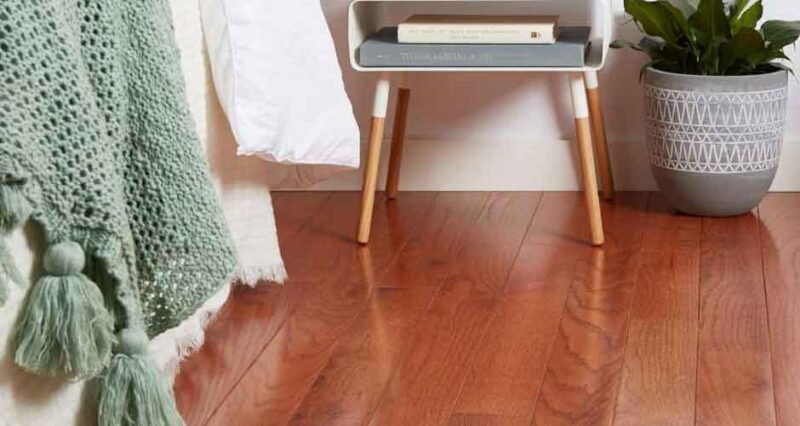
More and more, people who own homes are thinking about the planet when they make changes to their homes, especially when it comes to refinishing wooden floors. The old ways of doing this often use harmful chemicals that can hurt our health and the environment. This article talks about these dangers that people don’t usually think about and offers green, safe ways to refinish floors. These methods not only make floors look better but also help make our homes healthier and better for the planet.
The Hidden Dangers of Traditional Hardwood Floor Refinishing
Making wooden floors look new again is a common way to keep them beautiful and lasting longer. But, the usual ways of doing this have hidden risks that many people don’t know. These dangers primarily arise from the chemicals used and the methods of sanding, staining, and sealing the hardwood floor refinishing process.
The Process and Its Risks
- Sanding: Usually, the first thing to do when refinishing wooden floors is sanding. This step is meant to take off the old layer and smooth the surface. But, sanding can let out dust and small bits that might have old varnishes or finishes with toxic parts.
- Coloring: After sanding, color is often added to make the wood look a certain way or to make its color even. A lot of old-style colors have a lot of VOCs (Volatile Organic Compounds). VOCs are chemicals that turn into gas at room temperature and can be breathed in. They are bad for the planet and can be harmful to people.
- Sealing: Lastly, to keep the new color safe and make it shiny, sealants are used. Like the colors, many old sealants have a lot of VOCs. They make the wood last longer but also let out dangerous chemicals into the air.
Health Implications
The health implications of exposure to high levels of VOCs and other chemicals in traditional hardwood floor refinishing products are significant. Here are some of the potential health issues:
- Short-term Effects: Exposure to high levels of VOCs can lead to immediate symptoms such as headaches, dizziness, throat and eye irritation, and respiratory problems. People with asthma or other respiratory conditions may experience exacerbated symptoms.
- Long-term Effects: Prolonged or repeated exposure to these chemicals can have more severe long-term health effects. This may include liver, kidney, or central nervous system damage. Some chemicals used in traditional floor refinishing products have also been linked to an increased risk of cancer.
Environmental Impact
The environmental impact of these chemicals is also a concern. VOCs contribute to the formation of ground-level ozone and smog, which have negative effects on outdoor air quality. Moreover, the production, disposal, and evaporative emissions from these chemicals can have broader impacts on ecosystems and wildlife.
Why Eco-Friendly Refinishing is a Great Choice
Choosing eco-friendly ways to refinish hardwood floors brings many advantages:
- Healthier Home Air: These methods reduce harmful chemical emissions, making your home’s air cleaner and safer.
- Environmentally Friendly: They are better for the planet, reducing the release of dangerous chemicals into the air and supporting earth-friendly practices.
- Durable, High-Quality Finishes: Green options provide finishes that last long and enhance the natural appeal of the wood.
- Variety of Choices: There are many green finishes available, so you can find one that suits your home’s style and your taste, enhancing your home’s beauty.
Water-Based Finishes: A Safer Choice
- Low in Harmful Chemicals: Water-based finishes have low levels of VOCs (Volatile Organic Compounds). They release far fewer dangerous chemicals than standard polyurethane finishes, making them a healthier choice for the air inside homes.
- Quick to Dry and Keeps Wood’s True Color: Water-based finishes also dry quickly, which means less hassle for homeowners. They’re great at keeping the wood’s original color, so the floors look natural and authentic.
Natural Oil Finishes: Preserving Wood’s Essence
- Deeply Penetrates and Beautifies: Natural oils like linseed or tung oil soak into the wood. This not only makes the floors more durable but also brings out the wood’s natural patterns and beauty.
- Green and Sustainable: These oils come from sources that can be replenished. Using them supports eco-friendly practices and cuts down on artificial chemicals.
- Unique Look: Floors finished with natural oils have a special, gentle shine that adds a cozy, attractive feel to any home.
Low-VOC Products: Balancing Performance and Safety
- Less Chemical Risk: For those who like traditional finishes but worry about chemicals, low-VOC options are a good compromise. They have fewer dangerous chemicals, improving the air quality inside homes.
- Keeps Traditional Qualities: Even with fewer VOCs, these products still offer the strength and protection of traditional finishes. They’re a good fit for people who want a mix of eco-friendliness and effective performance.
How to Choose the Right Eco-Friendly Refinishing Option
Picking the right eco-friendly refinishing for your wood floors means thinking about various things. Each choice has its pros and cons, and the best one for you depends on what you need and like. Here’s a guide to help you decide wisely:
Assessing the Current Condition of Your Floors
Extent of Wear and Damage: Examine the level of wear, scratches, and damage on your floors. If your floors have minimal wear, a light sanding and a new coat of eco-friendly finish might be sufficient. For floors with deeper scratches or damage, more extensive refinishing may be required.
Type of Wood and Previous Treatments: Different woods react differently to refinishing processes. Also, consider any previous treatments your floors have undergone, as this can affect how they will respond to new finishes.
Determining the Desired Aesthetic Outcome
Color and Sheen Preferences: Think about the color and sheen you desire for your floors. Water-based finishes generally retain the wood’s natural color and offer a clear, non-yellowing finish, while natural oil finishes deepen the wood’s color and provide a soft, matte sheen.
Overall Look and Feel: Consider the overall look you want to achieve. Do you prefer a modern, sleek look or a more traditional, warm appearance? This will influence your choice of finish.
Maintenance Commitment
Frequency of Refinishing: Different finishes have different lifespans. Water-based finishes might need more frequent recoating than oil-based or low-VOC alternatives.
Daily Maintenance: Some finishes require specific cleaning methods. For instance, natural oil finishes might need regular oil applications, while water-based finishes can be easier to maintain on a day-to-day basis.
Environmental and Health Considerations
VOC Levels and Indoor Air Quality: If maintaining indoor air quality is a priority, particularly for homes with children, pets, or individuals with allergies, opting for low-VOC or VOC-free products is crucial.
Sustainable and Renewable Options: If environmental sustainability is a significant concern, look for products like natural oil finishes derived from renewable resources.
Consulting with a Professional
Expert Assessment: A professional can assess the condition of your floors and recommend the best eco-friendly options based on their expertise.
Tailored Solutions: Professionals can provide tailored solutions that align with your aesthetic preferences, maintenance willingness, and health and environmental concerns.
Quality Assurance: A professional can ensure that the refinishing process is done correctly, which can extend the life of your floors and improve the overall outcome.
Summary
Choosing eco-friendly ways to refinish hardwood floors is better for the planet and your health. As a homeowner, you should think about how your floors look now, what you want them to look like, and how your choices affect the environment. Expert advice can help you make choices that are good for both you and the Earth.

